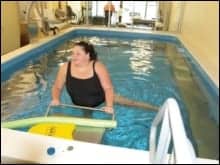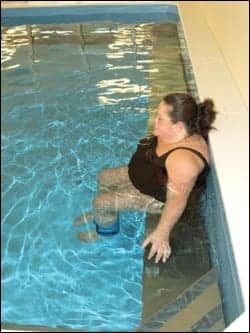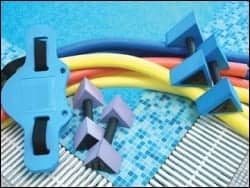
Aquatic therapy is more than recreational time in the swimming pool. Increasingly, it is prescribed as part of the physical therapy program for patients with disabling neurological disorders. The buoyancy of water allows for greater freedom of motion. Comorbidities such as arthritis and muscle inflammation are aided by the soothing benefits of warm water. Depending on their needs, patients can benefit from regaining range of motion, balance, muscle control, and improved independence with function and mobility.
Its multiple benefits can be experienced by patients in pediatric, adult, and geriatric populations. Children with conditions such as cerebral palsy, muscular dystrophy, and developmental delays may have aquatic therapy in their care plans. Among adult and geriatric populations, common diagnoses include spinal cord injury, stroke, brain injury, and Parkinson’s disease.
At Good Shepherd Rehabilitation Network, we use aquatic therapy for both inpatient and outpatient programs. Access is not an issue, making it a therapy that both ambulatory and nonambulatory patients can use. If a patient cannot enter the water using stairs, we have a hydraulic chair to get people into the water. Neurorehabilitation patients often receive therapy on land in combination with aquatic therapy. We spend about an hour with patients in the pool each session, but, as with other physical therapy, the benefits extend beyond the time they spend in the water. Contraindications for aquatic therapy include incontinence, open wounds, and uncontrolled seizures.
Aquatic therapy offers many benefits, and the psychological boost it provides cannot be underestimated. When the fear of falling deters patients or slows their progress on land, they can feel safe in the water. For example, therapists may challenge patients’ balance with higher-level exercises in the water, where falling is unlikely to cause injury. The accomplishment of more difficult tasks builds confidence in the patients.
PSYCHOLOGICAL BENEFITS
Additional psychological benefits are noted as patients realize that they can perform tasks in the water that they cannot do on land. Even the slightest movement can encourage the patient. Patients recognize that they can perform activities with less support and experience an increase in independent movement when in the pool. A neurological injury or disease may confine a patient to a wheelchair, presenting a significant lifestyle change. However, they may be able to take a few more steps or reach higher since their movements are aided by the buoyancy and support of the water. A patient who needs help lifting his knee on land to accomplish activities such as getting dressed or taking a step may be able to do it unaided in the water. The aquatic therapist who chooses activities to foster patient success also stimulates motivation and confidence.
When tone reduction has occurred, the rhythmic motion of the water can help until muscles physiologically relax. Water also is good to counteract swelling and promotes venous return.
A neurological injury or disease may confine a patient to a wheelchair, which becomes the primary means for mobility. Independence with vertical positioning and dynamic standing activities is often restricted when on land. In the pool, however, muscle weakness and limitations in sustaining vertical positioning become less apparent.

Physical therapy patient Kim Krafczyk in the facility’s warm water therapy pool.
ADAPTING THERAPY FOR THE POOL
Many land-based techniques used by the therapist can be modified for use in the water, and, with assistance, dynamic activities may be initiated earlier. Ambulation training often can begin sooner when it is performed in the water. A patient who can only stand at parallel bars on land may be able to walk using the bars in the pool. For instance, paraplegics may not be functional with standing activities on land, but can move in water with the support of parallel bars. The therapist assists with their stance and facilitates swing. Often, this assistance and cueing reduces or eliminates the need for bracing that is necessary on land. A patient with hemiplegia after suffering a stroke may be treated similarly. Additional manual cueing at the pelvis can facilitate increased weight bearing on the affected side and equalize steps.
The water is a good environment to practice other functional movements, such as squatting and negotiating a step. For someone who is significantly weak, being in the water reduces the amount of weight-bearing load, and promotes flexion activities such as lifting up the foot and placing it on a step. The therapist may provide manual cueing at the pelvis to facilitate stepping up or stepping down, so that compensatory patterns are not developed. As strength improves, the patient can move to more shallow water where gravity is greater as they progress toward resuming function on land.
Stroke patients sometimes pose special challenges in the aquatic environment, where buoyancy must be counteracted to reduce tone in the antigravity muscles. When hip and knee extensor control is poor, the patient may develop increased flexor tone in the pool in the affected lower extremity. Applying an ankle weight may help. The therapist also may need to provide manual cueing for weight shifting and weight acceptance to help the patient stand on the involved leg. On land, patient progress can be affected by how much body weight can be supported, but in the pool weight bearing is reduced to about 50% when the patient is at waist depth.
If the therapist is unable to challenge a patient to work in an upright position, or needs to further isolate affected muscle groups, the supine floating position can be utilized as in the Bad Ragaz Ring Method (a form of active or passive aquatic therapy modeled after the principles and movement patterns of Knupfer exercises and proprioceptive neuromuscular facilitation). For example, weakness in the hip abductors can be facilitated and resisted in this position, by performing jumping jack-type movements. Common compensations such as trunk lateral flexion can be discouraged easily, as the patient is focusing solely on one movement, not a combination as is done when standing. Abdominal stabilization can be challenged by laterally swaying the patient through the water, with verbal cues to tighten the trunk and the hips. The therapist’s hold may be moved from the hips to the ankles, or from the scapula to the elbows with the shoulders abducted, to increase difficulty.

Incorporating such tools as weighted belts, dumbbells, and noodles, can enhance an aquatic therapy regimen.
Working with children in the pool is similar to working with adults. Many deficits and treatment objectives are the same; however, treatments need to incorporate creative play activities in order for children to remain interested and be compliant. Often, using the concepts of the developmental sequence during treatments is helpful.
Whether working with children or adults, there are tools that can enhance rehabilitation process. For example, to enhance resistance training, webbed gloves can be used, as well as resistive tubing, hydro dumbbells, and weights. Strengthening and balance programs can be augmented by introducing the use of foam rollers, noodles, hydro boots, and floatation belts. Underwater treadmills and bikes also add dimension to a therapeutic regimen. Whatever the tool or equipment, the ultimate goal of the aquatic therapy program is to return the patient to strength, mobility, and, ultimately, independence.
Continuing aquatics after patients are discharged from their therapy program has benefits for patients with neurological disorders. Just as they can be given exercises to do at home to complement physical therapy on land, aquatic therapy patients can continue to work on their own in the pool. Patients need to be educated on progressing in the program, which may include introducing more challenging exercises for balance or increasing resistance of current exercises. Family members also can be trained to assist them. Many times, patients take advantage of joining the pool as a fitness member once their therapy is complete.
Sara Sommer, MS, PT, is a therapist at Good Shepherd Rehabilitation Network in Allentown, Pa. Sommer has practiced in aquatics for 6 years, working with orthopedic and neurological patients. She attended Misericordia University. For more information, contact .





